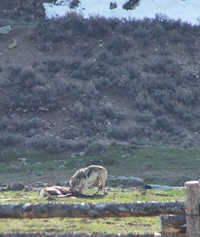Depending on who's asked, the transfer of gray wolf management in the Northern Rockies to state wildlife agencies by the federal government will either be a day to be celebrated or a day to be feared.
Long anticipated, the change in wolf management officially comes to pass today, Friday, March 28.
In the minds of supporters of the transfer of management to the states of Idaho, Montana and Wyoming, the change is considered long overdue. Since 66 wolves were reintroduced to central Idaho and Yellowstone National Park in 1995 and 1996, the population of the wild canines has steadily grown to the point at which it now numbers more than 1,500 in the tri-state region.
But in the minds of wolf advocates, today's milestone may signal the beginning of an all-out assault against the charismatic wildlife species.
In late February, conservation groups notified the U.S. Fish and Wildlife Service that it is violating the federal Endangered Species Act by removing gray wolves from the endangered species list. The organizations contend that populations in the Northern Rockies do not have adequate genetic diversity, and that the states of Idaho, Wyoming and Montana have not made meaningful commitments to wolf conservation. The groups, which include Hailey-based Western Watersheds Project, gave a 60-day notice of their intent to sue to challenge the agency's decision in federal court.
According to multiple news reports, the groups do not plan to file to stop the delisting until April 28, unless the states begin allowing significant numbers of wolves to be killed. Under a requirement of the Endangered Species Act, the groups are barred from filing until 60 days after the FWS released its delisting decision, which happened on Feb. 28.
Defenders of Wildlife, a Washington, D.C.-based conservation group that works with ranchers to help them avoid wolf-livestock encounters, has said it will not support delisting until the states establish sustainable management plans.
"Given the tremendous public support and resources spent to reintroduce the wolf to the Northern Rockies, it makes no sense to allow wholesale killing of wolves in the region and polarize the issue even more deeply with this one-sided plan," the organization's Northern Rockies wolf conservation specialist Suzanne Stone said in late February after the delisting process was set in motion.
Stone called for a "balanced solution based on science that also addresses the needs of ranchers, wildlife supporters and hunters."
But according to federal officials, the gray wolf population in the Northern Rocky Mountains is thriving and no longer requires the protection of the Endangered Species Act.
"The wolf population in the Northern Rockies has far exceeded its recovery goal and continues to expand its size and range," Deputy Secretary of the Interior Lynn Scarlett said in February. "States, tribes, conservation groups, federal agencies and citizens of both regions can be proud of their roles in this remarkable conservation success story."
Scarlett noted that there are now at least 100 breeding pairs in Montana, Idaho and Wyoming.
The FWS claims that state management plans approved previously by the federal agency will provide a secure future for the wolf population once Endangered Species Act protections are removed and the states assume full management of wolf populations within their borders. Today's delisting covers all of Idaho, Montana and Wyoming, as well as eastern portions of Washington and Oregon, and a small part of northcentral Utah.
Under the original recovery plan that put in motion the 1995 and 1996 reintroduction, the federal government set the minimum recovery goal for wolves in the Northern Rocky Mountains at a minimum of 30 breeding pairs and 300 individual wolves for at least three consecutive years. A breeding pair represents a successfully reproducing wolf pack. The FWS goals were first achieved in 2002, and the wolf population has expanded in size and range every year since.
Barring a successful appeal of the Northern Rockies wolf delisting, today's move by the federal government could mean the beginning of wolf hunting as early as this fall in the states of Idaho, Montana and Wyoming. Wyoming's management plan classifies wolves outside of the northwest part of the state as predators, which allows unlimited shooting of them as of today.
In recent years, Idaho's wolf population has been growing at an annual rate of 20 percent, according to Idaho Department of Fish and Game figures.
At the end of 2007, Idaho had an estimated 732 wolves, Fish and Game's large carnivore manager Steve Nadeau said last month. He predicted the population will increase 15 percent to 20 percent by this fall.
Nadeau said the department's goal for the next five years is to keep the Idaho population between the 518 counted in 2005 and 732.


 Gray wolves living in the Northern Rockies are scheduled to lose their federally protected status today, Friday, March 28, and will become the responsibility of state wildlife agencies. The transfer of management oversight could mean the beginning of wolf hunting in the states of Idaho, Montana and Wyoming as early as this fall.
Photo courtesy of Idaho Department of Fish and Game
Gray wolves living in the Northern Rockies are scheduled to lose their federally protected status today, Friday, March 28, and will become the responsibility of state wildlife agencies. The transfer of management oversight could mean the beginning of wolf hunting in the states of Idaho, Montana and Wyoming as early as this fall.
Photo courtesy of Idaho Department of Fish and Game



































